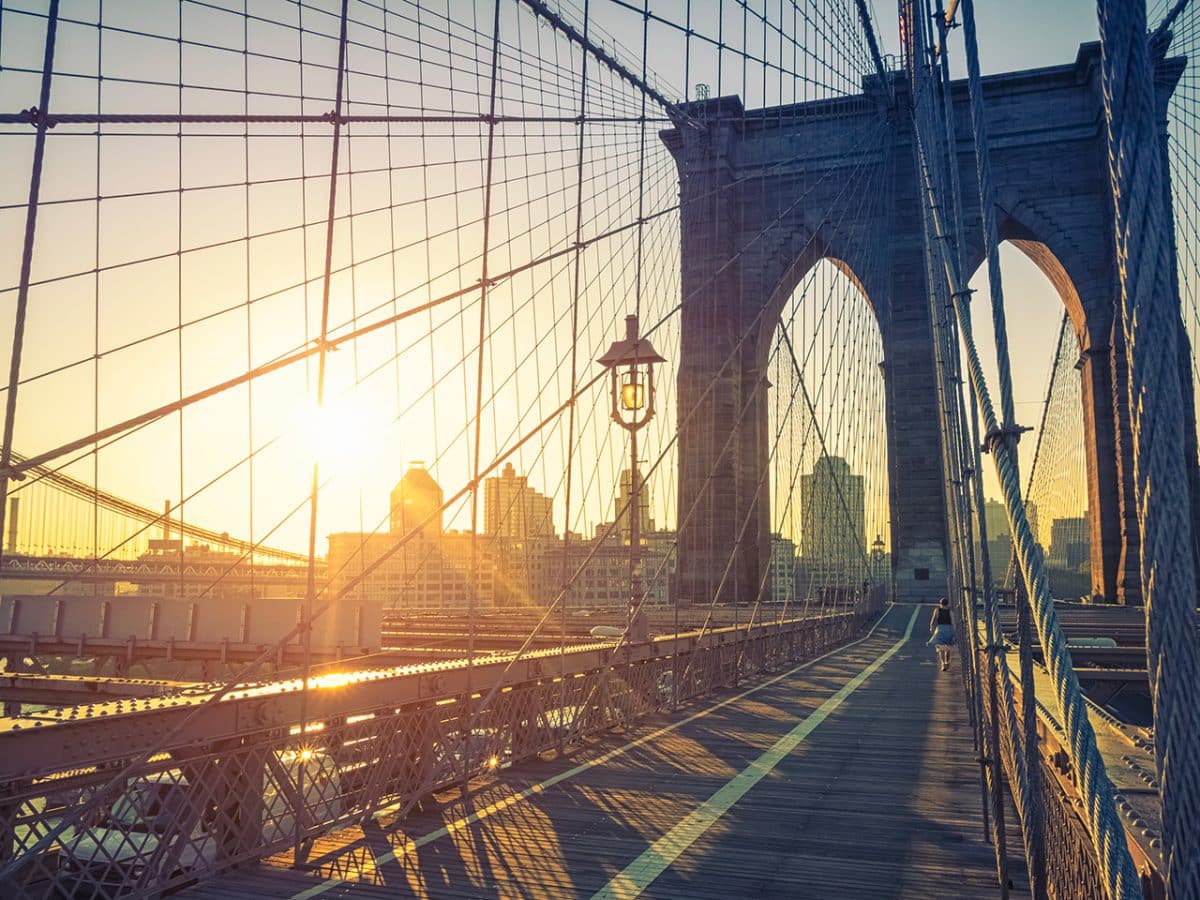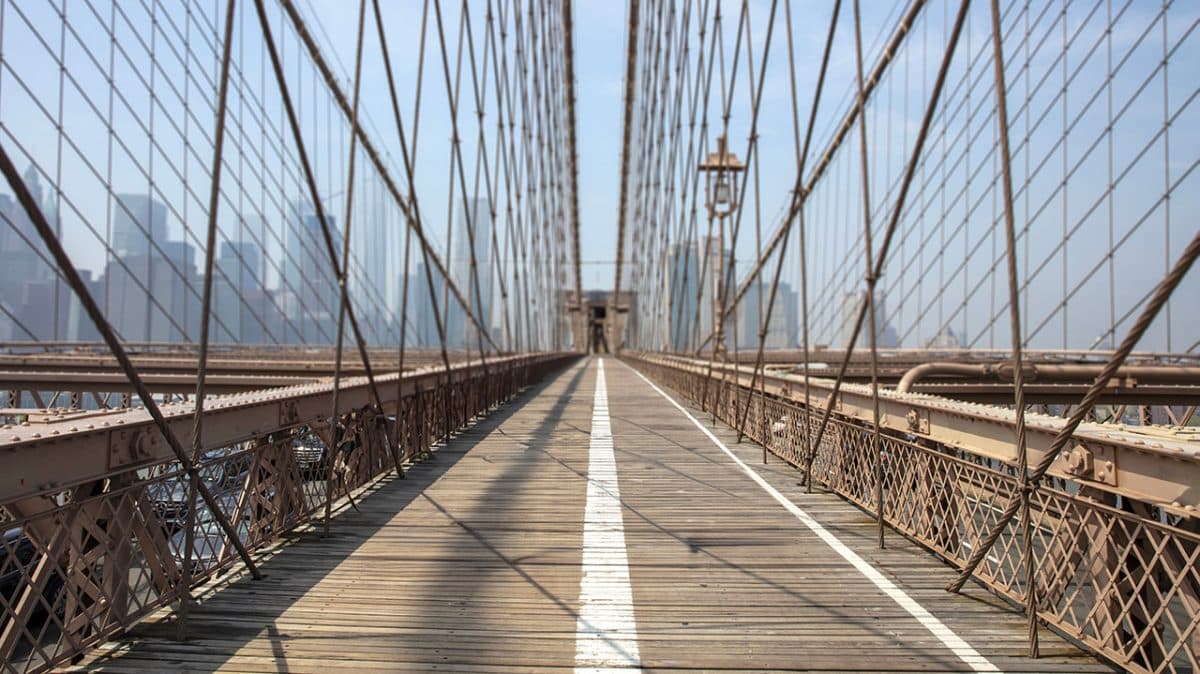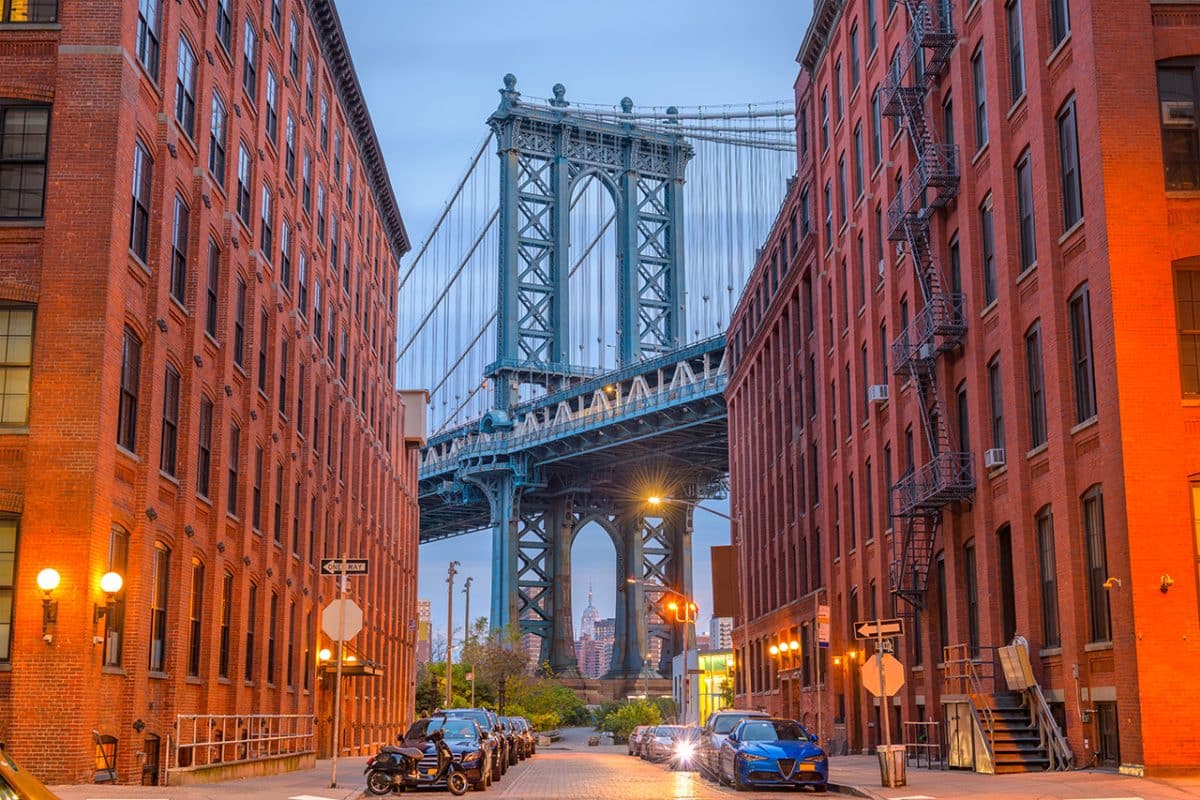In the heart of New York stands the majestic Brooklyn Bridge, the world’s first structure suspended by steel cables. 1.8 km long and spanning theEast River, this historic monument has linked Manhattan to Brooklyn since 1883. Much more than just a passageway, this engineering marvel attracts millions of visitors every year, fascinated by its unique architecture and the exceptional views it affords of the New York skyline. With over 140,000 vehicles, cyclists and pedestrians passing through every day, this architectural jewel remains a vibrant and functional part of the urban landscape, and a testament to the bold vision of its designers.
An architectural masterpiece and a New York landmark
Construction saga: between genius and sacrifice
The story of the Brooklyn Bridge began in 1869 under the impetus of engineer John August Roebling. This titanic project quickly became a family saga after Roebling suffered a fatal accident on site. His son Washington Roebling took over, only to be seriously disabled by a decompression accident. In the end, it was his wife, Emily Warren Roebling, who oversaw the work for 11 years, becoming the first unofficial female site manager in American history. On 24 May 1883, after 14 years of hard work, the bridge was inaugurated in the presence of President Chester Arthur and 150,300 pedestrians who had come to admire this technical feat. The total cost was 19 million dollars at the time (the equivalent of 320 million today), a colossal investment that testifies to the ambition of the project.
Unfortunately, building the bridge took a heavy human toll: 27 workers died during the work. Among the many technical innovations, the pioneering use of steel cables (rather than iron as was the norm) revolutionised the art of bridge building. At John Roebling‘s insistence, these cables were designed to be six times stronger than necessary – a precaution that enabled the bridge to withstand more than a century of increasing traffic without failing.
Curiosities and little-known facts
The Brooklyn Bridge is full of fascinating anecdotes. A year after its inauguration, doubts persisted as to its solidity. To reassure the public, the famous circus director P.T. Barnum had the audacious idea of having 21 elephants cross the bridge in May 1884 – a spectacular demonstration that left a lasting impression.
Just six days after the bridge opened, rumours of its collapse caused panic among pedestrians, resulting in the deaths of 12 people in the stampede. This tragic incident shows the extent to which this gigantic structure both impressed and worried New Yorkers at the time.
On the day of the inauguration, a record number of 150,300 pedestrians crossed the structure. Even today, the number of people crossing the bridge remains impressive, with 107,000 vehicles, 32,000 pedestrians and 4,000 cyclists using it every day.
Over the decades, the bridge has become a major source of artistic inspiration. Painter Georgia O’Keeffe immortalised it in her painting“Brooklyn Bridge” (1949), while films such as“Once Upon a Time in America” and“Spider-Man” have used its iconic silhouette as a backdrop.
How to organise your visit
For the best experience, start your journey on the Brooklyn side. The ideal starting point is near the High Street underground station (lines A and C). From this entrance at Washington Street level, you’ll not only have the best view of the Manhattan skyline, but you’ll also enjoy a slight downhill slope that makes the walk more pleasant. Allow at least 45 minutes to enjoy the walk to the full, stopping at strategic points to admire the panorama and take photos.
The morning hours offer magnificent light and less dense crowds, while sunset transforms the cityscape into a symphony of golden lights. To enhance your experience, don’t hesitate to download the“Eric’s New York” app, which offers a comprehensive“DUMBO – Brooklyn Bridge” guided tour, including the adjacent districts in your itinerary.

An exceptional visual experience
Crossing the Brooklyn Bridge is a visual feast. With every step, new perspectives open up on Manhattan’s iconic skyline. In the middle of the bridge, take time to admire the neo-Gothic towers that support this impressive structure. The striking contrast between 19th-century architecture and modern skyscrapers creates a timeless image of New York.
From the central promenade, your eyes can take in a panoramic view stretching from the Statue of Liberty in the south to the buildings of Midtown in the north. TheEmpire State Building and One World Trade Center stand out majestically on the horizon. The steel cables that form elegant lines overhead offer unique photographic opportunities. The perspective changes constantly as you move along, transforming each section of the bridge into a new living postcard.

Explore the adjacent neighbourhoods
Once you’ve crossed the bridge, take the time to explore the neighbourhoods that border it. On the Brooklyn side, the DUMBO district (an acronym for“Down Under the Manhattan Bridge Overpass“) is well worth a visit. Once an industrial zone, this area has been transformed into a hip spot where art galleries, independent boutiques and trendy cafés have set up shop in former brick warehouses.
A short walk away is the charming residential neighbourhood of Brooklyn Heights, with its 19th-century brownstone houses and shady streets. The very name‘Brooklyn‘ bears witness to the city’s Dutch heritage, deriving from‘Breukelen‘, a town in the Netherlands. This rich history is reflected in the varied architecture and cultural vibrancy of the district, where street art rubs shoulders with century-old buildings.
Don’t miss the magnificent Brooklyn Bridge Park, an 85-acre urban oasis along the eastern bank of theEast River. Built on former port areas, this park offers impeccable green spaces, children’s play areas and sports facilities, all with a breathtaking view of Manhattan and the two surrounding bridges.
Breaks and refreshments
After your walk, there are several options available to you to recharge your batteries. The Empire Stores complex, located in a renovated former DUMBO warehouse, is home to a number of cafés and restaurants with breathtaking views over the bridge. For an authentic New York pizza, head to Juliana’s Pizza on Old Fulton Street, regularly cited as one of the best in the city.
If you prefer a more casual option, there’s a Shake Shack nearby, offering burgers and milkshakes in a typically American atmosphere. To end your day on a festive note, Brooklyn ‘s local bars offer an immersion in New York nightlife, with establishments ranging from traditional pubs to sophisticated cocktail bars.
Picnic lovers will be delighted by the green spaces of Brooklyn Bridge Park, ideal for a lunch break with a panoramic view of the skyline.

Practical tips for a successful visit
To make the most of your crossing, bring comfortable shoes, a bottle of water and sun protection. As the bridge is completely exposed to the elements, bring a hat in summer and a windbreaker in cooler weather. The pedestrian walkway and cycle path are clearly separated – be vigilant and respect this demarcation to avoid any incidents.
There are several observation points along the way, where you can take a break and admire different views of the city. Don’t hesitate to stop regularly to enjoy the changing views and rest your legs.
The total crossing time is around 45 minutes at a leisurely pace, but allow more time if you want to take photos or simply enjoy the experience without rushing. The route has a slight downhill slope towards Manhattan, which makes it particularly enjoyable.
Crossing alternatives
Although crossing on foot offers the most complete and immersive experience, there are other options. Cyclists can use the dedicated path that runs alongside the motorway. Cycle hire is available on both sides of the bridge, but beware: cycle traffic can be heavy at peak times.
For those who prefer a more educational approach, guided tours are offered by several operators. These tours offer detailed information on the history, architecture and anecdotes associated with the bridge. They are an added value for history and architecture buffs.
An interesting alternative is to view the bridge from the water, during a cruise on theEast River. This unique perspective allows you to fully appreciate the majesty of the structure and its integration into the urban landscape.
For amateur photographers
The Brooklyn Bridge is a photographer’s paradise. For spectacular shots, try framing the Gothic arches with the Manhattan skyline in the background. The criss-crossing steel cables create striking geometric lines that naturally guide the eye towards the city skyline.
Morning light bathes the structure in a golden glow, while sunset transforms the skyline into a tableau of pink and orange hues. For less conventional shots, head to Pebble Beach in DUMBO or the nearby Manhattan Bridge, which offer different angles on this New York icon.
Seasonal effects add an extra dimension: the morning mist of spring envelops the towers in a mysterious atmosphere, while the winter lights create a fairytale-like ambience. The classic composition consists of framing theEmpire State Building between the Gothic arches – a timeless snapshot that every visitor must capture.

A living cultural heritage
Beyond its primary function, the Brooklyn Bridge embodies the very spirit of New York: ambitious, resilient and forward-looking. This structure played a crucial role in uniting Brooklyn and Manhattan, helping to shape the metropolis as we know it today.
A universal symbol of New York
The bridge has spanned more than a century of American history, surviving storms, wars and the constant evolution of the city that surrounds it. Its silhouette has become a universal symbol of New York, instantly recognisable the world over.
Crossing the Brooklyn Bridge is more than just a journey – it’s an immersion in the city’s living history, a multi-sensory experience that combines the roar of the traffic below, the wind whistling through the cables and the urban panorama that unfolds as far as the eye can see. It’s walking in the footsteps of the generations of New Yorkers who have taken it before you, contributing to the continuing legend of this engineering marvel that transcends its utilitarian function to achieve the status of monumental work of art.
Useful information
- Opening times: 24 hours a day.
- Admission: free


